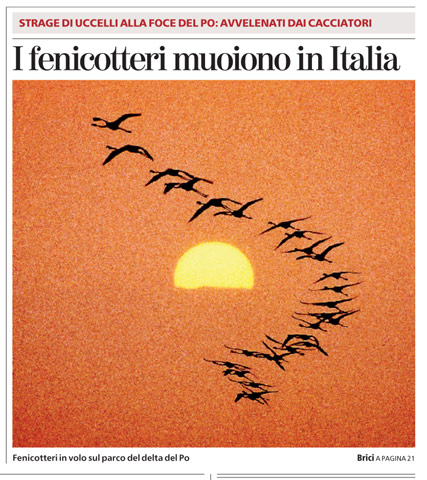
How and where lead accumulates.
When a shotgun shell is fired, only a small fractionof the shot strikes the target. The rest of the pellets fall back to earth, where the pellets accumulate in the soil either on land or on the bottom of wetlands or other water bodies. Near waterfowl blinds or in agricultural fields where hunting activity is high, lead shot historically accumulated in substantial amounts.
The Dangers of Lead for Birds
Birds’ digestive systems.
Birds are poisoned when they ingest lead shot found in the soil or in wetlands. Because birds lack teeth, they swallow their food whole. Along with their food, birds swallow small pebbles, called grit, which grind the food in the gizzard. Aquatic birds, particularly ducks, geese, and swans, use the sensitive tissues in their bills to detect particles of food and grit in the soil or in mud at the bottoms of lakes and wetlands – but waterfowl are unable to distinguish lead shot from pebbles, and may also ingest the toxic lead pellets.
Lead’s deadly effects.
Lead pellets enter the gizzard, where they are ground into smaller particles and partially dissolved by digestive acids. The dissolved lead combines with other elements in the bird’s digestive tract and is absorbed into the bloodstream, where it inhibits the ability of hemoglobin to carry oxygen, and reduces the number of red blood cells. Depending on the dose of lead, it may take only a few days for the bird to experience anemia, and its muscles weaken. If the anemia is severe enough, the bird may lack the strength to eat, and slowly starve to death or die from the failure of vital internal organs (Bellrose 1975), or from neurological damage. Furthermore, weakened birds are more vulnerable to accidents, hypothermia, and predators, so their ability to survive is reduced even if the dose of lead itself is not lethal.
Toxic doses and wildlife mortality.
Lead is extremely toxic if eaten and absorbed into the blood. Symptoms of lead poisoning can appear as soon as four days after ingestion of as few as two to three pellets, with death occurring in 17 to 21 days. A single pellet has been shown to be lethal to birds as large as swans. Controlled studies conducted in the 1950s showed that ducks that ingested four 0.11-inch-diameter lead shot pellets suffered a mortality rate 41% higher than those that were free of lead (Bellrose 1975). The Canadian Wildlife Service estimated that 250,000 waterfowl died per year from lead poisoning in Canada (Scheuhammer and Norris 1995). It estimated that several million more waterfowl suffer sub-lethal effects, resulting in lower survival rates and reduced breeding success. Before the 1991 prohibition on lead shot for waterfowl hunting, it was estimated that two to three percent of the autumn and winter populations of waterfowl across the U.S. fell victim to lead poisoning each year (Bellrose 1976, p. 73). Lead shot in the environment also causes secondary poisoning of wildlife. This may happen when scavengers or predators such as owls, hawks, and eagles ingest lead while feeding on prey containing lead pellets, or on prey with lead-contaminated muscles and internal organs. The high number of endangered Bald Eagles lost to secondary lead poisoning in the 1970s was one of the primary reasons for the federal ban on lead shot for waterfowl hunting.























